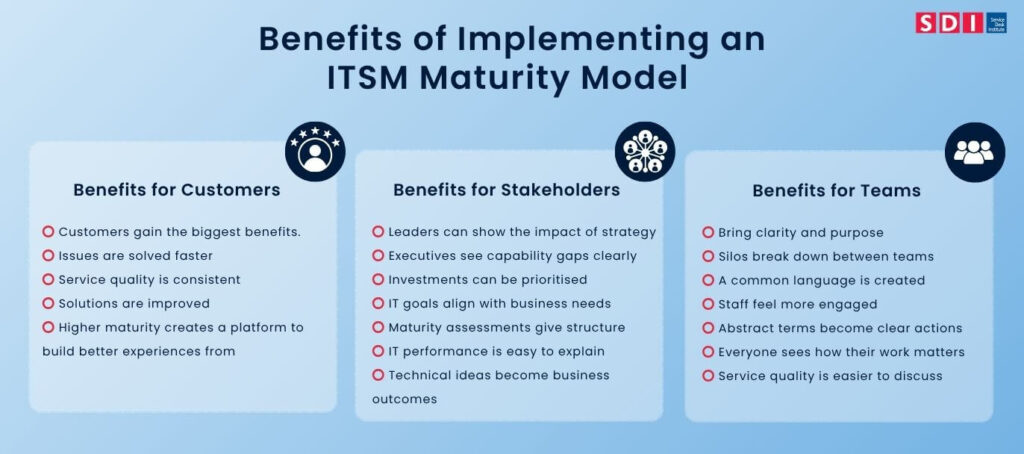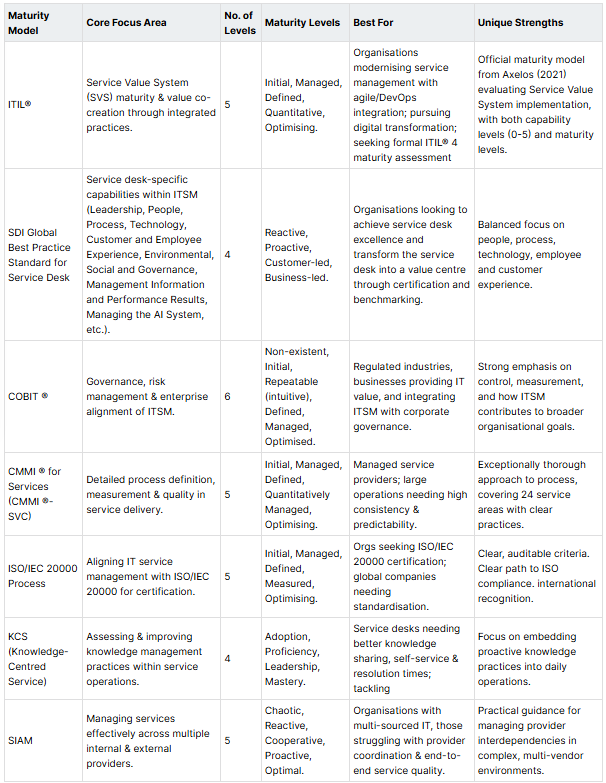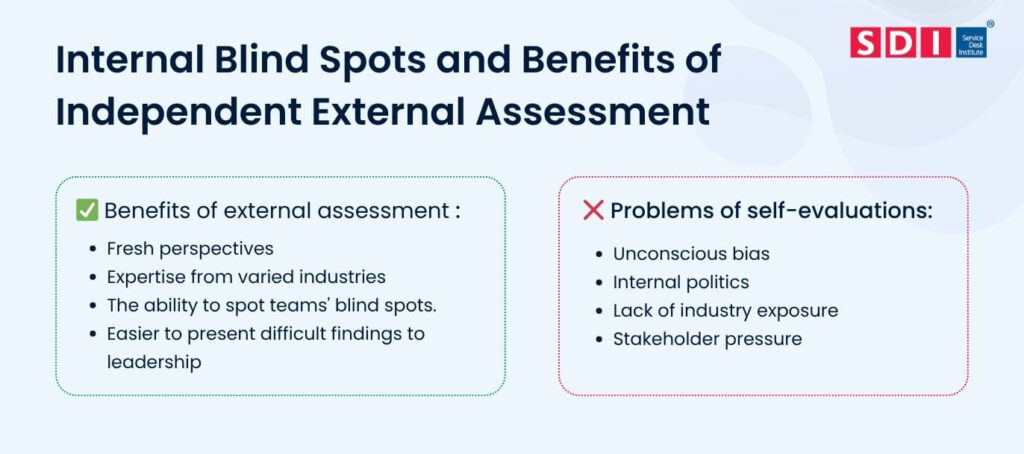 Back to Resources
Back to Resources
Let’s start with an uncomfortable truth: most IT teams are pushing strategic improvements to the next quarter because they’re busy putting out metaphorical fires every day.
Service desks are overwhelmed by repetitive tickets, IT functions get trapped in operational cycles, change processes create bottlenecks, and despite everyone’s best efforts, IT still struggles to demonstrate its true value to the business.
If that sounds familiar, don’t worry. You’re not alone.
We’ve worked with countless IT organisations facing these exact challenges. The good news? There’s a clear path forward. Breaking free from this reactive cycle starts with one simple step: understanding where you really stand today.
Getting a realistic assessment of your current IT service management (ITSM) maturity is the first step to improving your service delivery. It sets the stage for operational, tactical, and strategic improvement.
Without this clarity, you’re making improvements based on assumptions rather than real insights. We’ve seen how this approach drains resources and leaves teams frustrated.
This is where maturity models come in. Think of them as a GPS for your ITSM journey: They show you where your service operations stand now and the best route to where you want to be. There is no guesswork, just clear direction.
Note: Although these models focus on ITSM capabilities broadly, they’re still highly relevant to service desk teams. They offer a framework to evaluate your service desk practices, such as incident management, knowledge sharing, customer experience, and continual improvement.
In this post, we will explain different maturity models and their core features.
By the end of this post, you’ll know:
- Different ITSM maturity models
- Core features of each model
- When to use each model and its benefits
- Important things to consider for each model
As we discuss the different models, keep in mind that there’s no universal “perfect” maturity model. Different frameworks emphasise distinct aspects of service management. For example, some prioritise process optimisation, while others focus on cultural transformation or governance structures. The key is choosing the approach that best suits your organisational needs.
What is a Maturity Model in ITSM?
A maturity model in ITSM is a structured framework that helps organisations evaluate, assess and improve their IT service management processes, resources and practices.
Think of it as a roadmap that outlines the progressive stages of capability development. These models typically define multiple maturity levels, each with specific characteristics, benchmarks and expectations.
While these models assess ITSM capabilities broadly, service desks often serve as the primary touchpoint where these capabilities are put into practice, making them an ideal starting point for maturity assessments.
The road to choosing a maturity model starts with an ITSM maturity assessment.
Why do you need an ITSM Maturity Assessment?
An ITSM maturity assessment serves two primary purposes:
- Benchmarking: They provide objective criteria to measure your current performance against industry standards and best ITSM practices.
- Strategic planning: Once you know where your service desk currently sits on this scale, you gain valuable insights into your strengths, weaknesses and the practical steps needed to improve.
Benefits of implementing an ITSM Maturity Model
Unlike simple performance metrics that track incident volumes or response times, maturity models evaluate the underlying capabilities that drive these outcomes. When properly applied, these frameworks become powerful catalysts for meaningful transformation.

Benefits for Your Teams
For IT service management professionals, maturity models provide much-needed clarity and purpose. Staff engagement typically increases as team members understand how their individual contributions connect to the broader maturity journey.
It breaks down silos between cross-functional teams and creates a common language for discussing service quality. They translate abstract concepts like “service excellence” into concrete behaviours and actionable steps.
Benefits for Stakeholders
Maturity models enable leaders to prove the tangible impact of their IT strategy and investments. They also help executives understand current capability gaps, prioritise investments and align IT initiatives with business objectives.
A maturity assessment offers a structured framework for communicating IT performance to non-technical stakeholders by transforming technical concepts into business outcomes they can understand and value.
Benefits for Customers
Higher ITSM maturity levels create a platform for building better customer experiences. As organisations progress from ad hoc to optimised processes, they develop the capabilities needed to deliver faster resolution times, consistent service quality, and more effective solutions.
Supporting Continual Improvement
Maturity models help organisations avoid the frustrating cycle of enthusiastic starts followed by abandoned initiatives. Maturity models help you break this pattern for good.
Here’s how they create lasting change:
- No more random fixes – Instead of scattered efforts, you get a clear progression that builds on itself,
- Solve real problems – Stop treating symptoms and start addressing what’s really holding you back.
- Set realistic goals – Know exactly how long improvements take so you can plan (and celebrate) accordingly.
- Learn from others – See how similar organisations are succeeding and adapt their wins to your context.
They transform improvement from a series of projects into an ongoing journey with clear milestones and measurable progress. Improvement becomes part of your DNA.
Overview — The Most Recognised ITSM Maturity Models
Selecting the right maturity model requires understanding the unique focus and strengths of each framework. The table below provides a quick reference to the most widely adopted ITSM maturity models before we explore each in greater detail:

Deep Dive — The Leading Maturity Models in ITSM
A) ITIL ® Maturity Model
The ITIL ® 4 Maturity Model is a structured assessment framework developed by Axelos to help organisations objectively evaluate and enhance their IT service management capabilities. Rather than focusing solely on process compliance or ITIL ® adoption, the model examines the broader service management ecosystem—including people, technology, value streams, and partners—to provide a clear picture of organisational maturity and identify areas for continual improvement.
This model evaluates maturity across five progressive levels:
- Initial – Purpose and objectives are not consistently achieved
- Managed – Planning occurs, but processes are not standardised
- Defined – Organisation-wide standards are established
- Quantitative – Data-driven performance improvement
- Optimising – Continual improvement and optimisation
The ITIL® Maturity Model evaluates how effectively an organisation implements ITIL® 4’s Service Value System (SVS), a flexible operating model for value co-creation. It assesses the application of ITIL®’s seven guiding principles (such as “Start Where You Are” and “Progress Iteratively with Feedback”), the integration of its practices across the service value chain, and the adoption of modern ways of working (like Agile and DevOps)
Best suited for:
It’s ideal for organisations embracing digital transformation and looking to integrate traditional service management with Agile, DevOps, and other modern practices.
It’s particularly well-suited for larger enterprises with complex service management landscapes and organisations pursuing formal ITIL® alignment.
Things to keep in mind:
The ITIL® Maturity Model requires significant cultural change beyond process improvement. Success depends on embracing ITIL® 4’s guiding principles and shifting from process compliance to value-focused practices.
B) SDI Service Desk Maturity Model
The SDI Service Desk Maturity Model takes a unique approach by focusing specifically on service desk capabilities within the broader ITSM framework. It takes a holistic approach to service desk capability assessment. It draws inspiration from the EFQM excellence model while incorporating concepts from ITIL ® and ISO/IEC 20000.
The SDI Maturity Assessment Framework
The SDI framework recognises that service desks should consider dimensions that go beyond just processes.
It evaluates nine critical areas:
- Leadership and strategy
- People management
- Process efficiency
- Technology optimisation
- Customer experience
- Management and performance results
- Employee experience and wellbeing
- Environmental, Social, and Governance responsibility
- Managing the AI System
Each area is then assigned one of the four progressive maturity levels:
- Reactive (operational focus)
- Proactive (tactical focus)
- Customer-led (service focus)
- Business-led (strategic focus)
The SDI model offers a 360-degree view of service desk performance.
Best suited for:
The SDI framework is ideal for organisations looking to transform their service desk from a technical function to a strategic business partner. It’s especially valuable for companies seeking independent certification, benchmarking, or recognition of service desk excellence.
Things to keep in mind:
- The holistic nature of the SDI model means assessments can be time-consuming and require input across multiple teams and departments.
- Achieving higher maturity levels often involves significant cultural and leadership change, not just process or technology upgrades.
- The model’s broad scope can reveal gaps in areas (such as wellbeing or social responsibility) that organisations may not traditionally associate with IT service management. Be prepared to address these as part of the maturity journey.
c) COBIT® 5 Maturity Model
The COBIT® framework, developed by ISACA, provides a governance-oriented approach to assessing IT maturity. The current version, COBIT 2019, builds upon previous iterations to offer enhanced flexibility and alignment with modern IT practices.
This model evaluates maturity across six progressive levels:
- Non-existent
- Initial/Ad-hoc
- Repeatable but intuitive
- Defined process
- Managed and measurable
- Optimised
The model stands out for its strong focus on governance, risk management and enterprise alignment. It thoroughly assesses how well ITSM processes are controlled, measured and aligned with broader organisational goals.
Best suited for:
- Organisations in highly regulated industries, such as financial services, healthcare, and the public sector, where governance, compliance, and risk management are primary concerns.
- Businesses looking to show how service management contributes to enterprise value.
- Enterprises seeking to integrate ITSM maturity with broader IT governance or corporate governance initiatives.
Things to keep in mind:
- The COBIT® model’s strength lies in governance and control; it may be less detailed in operational or cultural aspects of ITSM compared to other frameworks.
- Success with COBIT ® can depend on organisational readiness to adopt formal controls and measurements.
- The emphasis on governance and control means the COBIT ® assessment process can be detailed and may require input from multiple stakeholders, not just IT.
- For organisations less concerned with regulatory requirements, the COBIT® model may be more complex than necessary compared to lighter-touch frameworks.
d) CMMI® for Services (CMMI-SVC)
Developed by the CMMI Institute, CMMI® Services is an integrated set of best practices designed to improve the performance and capabilities of organisations that deliver services, whether B2B, B2C, independent services or those included as part of a product.
The CMMI® for Services model, now part of CMMI V2.0, applies the rigorous Capability Maturity Model Integration methodology to service organisations.
This model evaluates maturity across five progressive levels:
- Initial
- Managed
- Defined
- Quantitatively Managed
- Optimising
CMMI-SVC is distinguished by its exceptionally thorough approach to process definition and measurement. It covers 24 service-related process areas, each with clear practices and goals at various maturity levels.
Best suited for:
- Managed service providers and large-scale service operations that require high levels of consistency, quality, and predictability.
- Enterprises where quantitative management, measurement, and continual improvement are critical requirements.
Things to keep in mind:
- The CMMI-SVC model involves significant effort in process documentation, measurement, and verification, which can be resource-intensive.
- The detailed requirements may be excessive for less mature or less regulated organisations.
- Success depends on a strong organisational commitment to ongoing process improvement and a culture of measurement.
e) ISO/IEC 20000 Process Maturity Model
The ISO/IEC 20000 Process Maturity Model helps organisations measure how well they manage IT services. It offers a clear path to certification compliance.
This model typically evaluates maturity across five progressive levels:
- Initial
- Managed
- Defined
- Measured
- Optimising
Best suited for:
- Organisations seeking to achieve or maintain ISO/IEC 20000 certification as a strategic goal or contractual requirement.
- Global organisations that need a consistent, standardised approach across multiple locations or regions.
Things to keep in mind:
- The model mainly focuses on compliance and auditability, which can be restrictive for organisations wanting more flexibility or innovation.
- The framework works best for organisations that have the resources and dedication to maintain strict process discipline.
- Smaller organisations or those not targeting formal certification might find the requirements burdensome without a clear business justification.
The model directly matches the needs of ISO/IEC 20000 certification. It offers a clear way to assess each service management process against the standard. It provides clear, auditable criteria for process maturity that independent assessors can verify. Its international recognition makes it particularly valuable for global organisations
f) KCS Maturity Model (Knowledge-Centred Service)
While KCS focuses specifically on knowledge management rather than overall ITSM maturity, we’ve included it here because effective knowledge management has become a cornerstone of effective ITSM.
Many organisations benefit from using KCS alongside a broader ITSM maturity model to support their overall service management goals with effective knowledge management.
The KCS Maturity Model is a framework for assessing knowledge management skills in service organisations based on the Knowledge-Centred Service method.
This model evaluates maturity across four progressive phases:
- Adoption (establishing the foundation)
- Proficiency (building consistent practices)
- Leadership (leveraging and improving knowledge)
- Mastery (optimising knowledge use)
The framework provides particularly strong guidance on evolving from reactive knowledge management to proactive content creation and self-service enablement.
Best suited for:
- Service desks and support teams aiming to enhance knowledge sharing, self-service, and incident resolution times.
- Service desks struggling from knowledge drain due to staff turnover
- Enterprises seeking to embed knowledge practices into day-to-day service operations.
Things to keep in mind:
- KCS needs a substantial culture change and ongoing staff involvement.
- The model focuses on knowledge practices specifically. For a full maturity picture, it should be complemented by broader ITSM assessments.
- Metrics and incentives may need to be realigned to encourage knowledge sharing.
It emphasises embedding knowledge practices into daily work rather than treating them as separate tasks.
g) SIAM Maturity Model
The SIAM (Service Integration and Management) Maturity Model is based on the SIAM Professional Body of Knowledge developed by the SIAM Foundation and Scopism. This model evaluates how effectively an organisation integrates and manages services across internal teams and external suppliers, focusing on governance, coordination, and end-to-end service accountability.
It addresses the increasingly common challenge of managing services across multiple providers. SIAM helps to bring clarity to a complex supply environment.
Its practical approach to managing provider interdependencies makes it invaluable in today’s complex service environments.
This model evaluates maturity across five progressive levels:
- Chaotic
- Reactive
- Cooperative
- Proactive
- Optimal
The SIAM model includes clear accountability frameworks, integrated toolsets, and collaborative processes that span organisational boundaries.
The model is most effective when there’s sufficient organisational scale and complexity to justify formal service integration efforts.
Best suited for:
- Organisations managing multiple suppliers or moving towards multi-sourced delivery models.
- Enterprises struggling with coordination, governance, or visibility across internal and external service providers.
- Organisations where end-to-end service quality depends on effective collaboration between different technical teams or external partners.
Things to keep in mind:
- SIAM maturity assessments require input from a wide range of stakeholders, both internal teams and external partners.
- Implementing SIAM practices can be complex, especially in organisations with supplier silos.
- The model is most effective when there’s sufficient organisational scale and complexity to justify formal service integration efforts.
What to Consider When Choosing a Model
Selecting the right maturity model is a strategic decision that will shape your improvement journey for years to come. The following considerations will help you identify the model best suited to your organisation’s unique context and aspirations.
- Business Goals and Strategic Alignment: Define your main goals for service management maturity. For example, choose COBIT® if compliance is key or ITIL ® for operational efficiency.
- Organisational Context and Culture: Select a model that fits your existing practices and culture. For instance, ITIL ® suits teams already immersed in ITIL ® practices, while CMMI works well for quality-focused organisations.
- Resource Availability and Timelines: Consider your capacity for improvement activities. Comprehensive frameworks like CMMI demand more documentation and resources, while simpler models provide immediate value for resource-constrained teams.
Choose a model that aligns with your goals, respects your culture, and matches your available resources.
Blending Models for Comprehensive Assessment
Many organisations can benefit from blending different models or switching frameworks as they grow. For example, they might use ITIL ® for technical areas while relying on the KCS model for knowledge management.
Similarly, smaller companies can start with a simpler model and transition to more rigorous frameworks as their capabilities mature. The main goal should be to get meaningful insights without overwhelming your organisation with unnecessary complexity.
Overcome Internal Blind Spots with Independent External Assessment
Many organisations fall into the trap of conducting self-evaluations.

While self-assessment offers flexibility and cost savings, it introduces several challenges:
- Unconscious bias misleads teams to overestimate their capabilities
- Internal politics and influencers skewing assessments
- Lack of industry exposure
- Stakeholder pressure sways assessments to appear more positive.
Independent external assessments provide crucial objectivity that internal evaluations often lack. External assessors bring:
- Fresh perspectives, unbiased by organisational politics
- Expertise from varied environments and industries
- The ability to see blind spots that teams have grown accustomed to
- Credibility for presenting difficult findings to leadership
This is where programmes like SDI’s Service Desk Certification deliver value. It combines the rigour of an established maturity model with independent, expert assessment.
Trained SDI auditors conduct a thorough on-site assessment, examining evidence, interviewing staff at all levels, and observing actual service delivery practices. It also delivers specific, prioritised recommendations tailored to your service desk’s current maturity level and strategic goals.
Final thoughts
Every IT organisation, regardless of its current ITSM maturity level, can take the next step forward. Service excellence isn’t about chasing perfection or getting a gold star on an assessment.
It’s about creating an environment where:
- Your team comes to work energised, not exhausted
- Your customers get the consistent, quality service they deserve
- Business leaders see you as the strategic partner you truly are
- Your tech and processes free you up to innovate, not hold you back
Remember, every success story began somewhere. The difference between those who achieve excellence and those who remain stuck in reactive cycles is their commitment to continual improvement.
Further Reading
To explore ITSM maturity models in greater depth, we recommend these resources from the SDI knowledge base:











